India IMF Deal = Tipping Point for Gold
 C/O the AdvisorAnalyst, written by Frank Holmes. Originally Published here:
C/O the AdvisorAnalyst, written by Frank Holmes. Originally Published here:
URL to article: http://advisoranalyst.com/glablog/2009/11/10/india-imf-deal-tipping-point-for-gold/
India-IMF Deal: Tipping Point for Gold
Posted By AdvisorAnalyst On November 10, 2009 @ 10:04 am In Markets | No Comments
By Frank Holmes
CEO and Chief Investment Officer
India’s deal to buy 200 metric tons (6.4 million troy ounces) of gold from the International Monetary Fund (IMF) is a huge deal – not just the fact that the New Delhi government is handing over $6.7 billion for the metal, but what it may mean for gold going forward.
India, the world’s largest gold jewelry market, is making a rational and bullish call on gold. The supply of gold continues to decline — the biggest supply is from socialist governments with socialist policies who’re selling their gold to pay for social welfare and bailout programs. The IMF is a classic case of this.
What’s particularly interesting in this case is that the buyer is a developing economy that’s the largest democracy in the world. I see this as another sign of the wealth shift away from the developed markets of North America and Western Europe toward the emerging world.
A decade ago, many of the major emerging markets were in shambles, with contracting economies and huge current account deficits – now many of them have large surpluses to deploy, and they’re thinking beyond Treasuries.
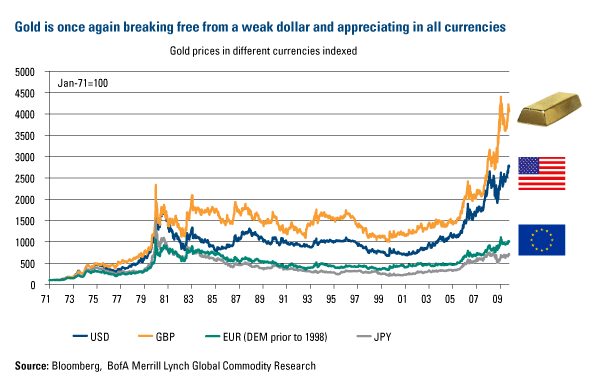
Energy analysts at Merrill Lynch came out with a research note today that predicts the price of gold will top $1,500 an ounce within the next 18 months. The rationale – a lack of confidence in major currencies will push investors toward gold as a hedge against competitive devaluation by the world’s largest economies.
The chart below lays out this scenario in a succinct way. Annual gold production is on a downward trend while the growth in money supply in both the United States and the Eurozone is bent almost straight up. Economics 101 — more money competing for a declining resource tends to drive up the price of that resource.
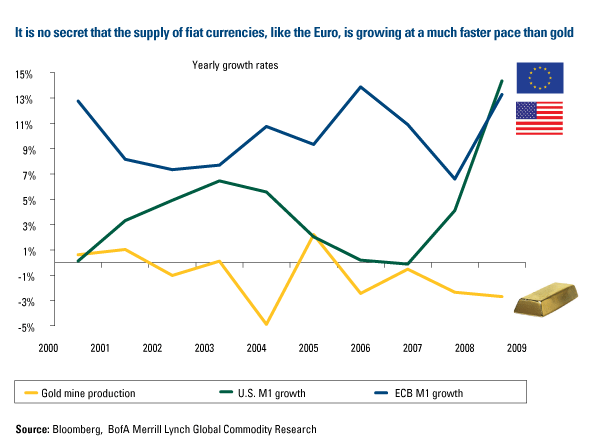
The note goes on to say that if gold prices rise, the price of energy and other commodities will rise as well. The chart below from Merrill Lynch shows the strong capital inflows into emerging markets starting in the second quarter of 2009 have both strengthened their currencies and boosted commodities demand.
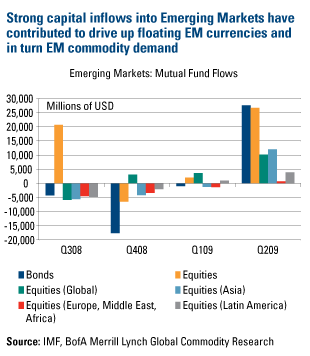
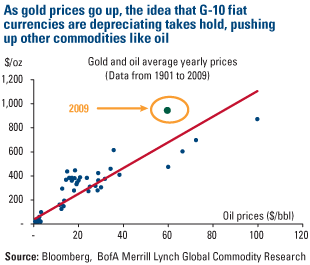
You also see that dynamic at work in the relationship between gold and oil over more than a century. Historically there is a strong positive correlation between gold and oil, and with 2009’s global monetary expansion, that correlation is being further strengthened. We’ve been writing about this correlation for many years.
Advertisement
<a href=”http://d1.openx.org/ck.php?n=a062ef31&cb=INSERT_RANDOM_NUMBER_HERE” rel=”external”><img src=’http://d1.openx.org/avw.php?zoneid=78807&cb=INSERT_RANDOM_NUMBER_HERE&n=a062ef31′ border=’0′ alt=” /></a> <sup>[2]</sup>
It’s significant that, on an inflation-adjusted basis, all of the natural resources except gold and silver have surpassed their previous all-time highs. Gold is only approaching the halfway mark to $2,300 an ounce, which would be its 1980 high when adjusted for inflation.
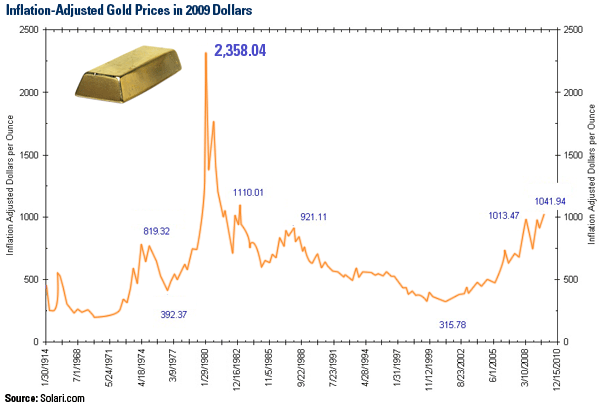
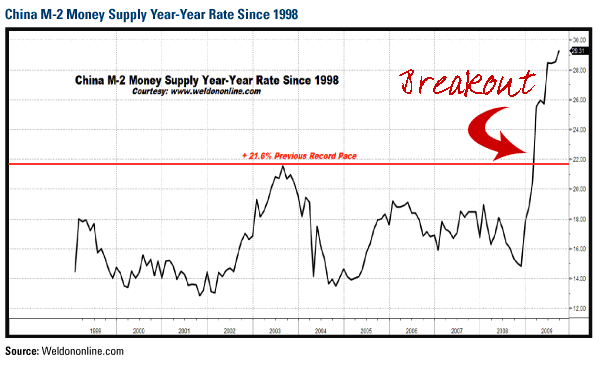
Just like in the U.S., money supply is exploding in China, as you can see in the chart above.
Greg Weldon, who analyzes money supply in the Weldon Money Monitor, had this to say recently: “September’s +29.5 percent year-over-year pace of monetary expansion represents the fastest ever recorded in China… Against a U.S.-focused macro-monetary backdrop that is defined by intensifying risk to reflation, the pressure on the (U.S. dollar) against the Chinese currency, in line with the highly expansionary monetary dynamic dominant in China, makes us more willing to explore the bullish side of global equities and commodities.”
Along with India, China has also been a major gold buyer – its reserves have nearly doubled since the start of 2003, when the price was about $345 an ounce. And, of course, now there’s talk that China may buy the remaining 203 metric tons that the IMF is seeking to sell.
Another thing about India or China is that their governments won’t be criticized for buying gold because as a nation, they have a strong cultural affinity toward it. It’s how they store their wealth, and they can wear it as jewelry.
If the U.S. government went out and spent nearly $7 billion for the IMF’s gold, there would be no end to the howling.
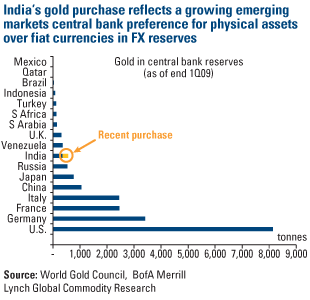 The disconnect amazes me – the U.S. holds virtually all of its foreign reserves in gold. We are the world’s largest gold holder, with more than double the amount as #2 Germany, but as a nation Americans are gold skeptics. Just this week, I was interviewed twice on television by two old-timers who are still clearly anti-gold. They just don’t want to get it. It appears they would prefer to live in a state of denial.
The disconnect amazes me – the U.S. holds virtually all of its foreign reserves in gold. We are the world’s largest gold holder, with more than double the amount as #2 Germany, but as a nation Americans are gold skeptics. Just this week, I was interviewed twice on television by two old-timers who are still clearly anti-gold. They just don’t want to get it. It appears they would prefer to live in a state of denial.
But in emerging Asia, the citizens get it. They say it’s a good move because they are buying gold, too — they believe in it.
And with this purchase from the IMF, India has gone from being a price taker as a jewelry consumer to being a price maker as an investor. This is the sort of change in government policy that we watch for in shaping and maintaining our investment models.
We monitor the seven most populous emerging markets and compare them to the G-7. It is significant that India, the second largest country in the world by population and the largest gold jewelry consumer, may have created a new floor for gold at $1,000 per ounce.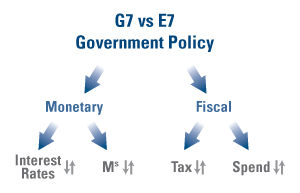
The presence of a big bullish buyer tends to create a big bullish buzz for gold. We’re seeing it now – gold today exceeding $1,100 an ounce – and history suggests it may last a while.
Around this time in 2005, for example, Russia announced that it was doubling its gold holdings from 5 percent to 10 percent of its reserves. At that time, gold was selling for about $490 an ounce. A year later, the price was up 30 percent.
Of course, Russian purchases weren’t the only thing that drove up gold – back then the dollar was dropping, federal deficits were colossal, markets were volatile and investors faced negative real interest rates.
We have the same conditions now, but on an even greater scale following the credit crisis, steep recession and the massive economic stimulus programs created around the world.
Our consistent suggestions is that investors consider a maximum 10 percent allocation to gold – half of the exposure in bullion and the other half in gold equities. The factors we’ve described above tend to be positive for gold and gold investing – the vote of confidence by a serious buyer like India may make a good situation even better.
Article printed from AdvisorAnalyst Views: http://advisoranalyst.com/glablog
URL to article: http://advisoranalyst.com/glablog/2009/11/10/india-imf-deal-tipping-point-for-gold/
URLs in this post:
[1] US Global Investors: http://usfunds.com
[2] Image: http://d1.openx.org/ck.php?n=a062ef31&cb=INSERT_RANDOM_NUMBER_HERE
[3] Image: http://creativecommons.org/licenses/by-nc-nd/3.0/





